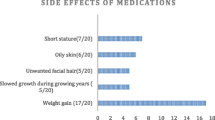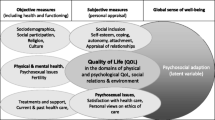Abstract
Purpose
To evaluate the quality of life of 6–11-year-old children and 12–17-year-old adolescents with disorders of sexual development (DSDs) following reparative surgery.
Methods
Fifty pediatric patients with DSDs, including 32 cases of congenital adrenal hyperplasia, 2 cases of complete androgen insensitivity syndrome, 1 case of partial androgen insensitivity syndrome, 6 cases of complete testicular dysgenesis, 7 cases of partial testicular dysgenesis, and 2 cases of ovotesticular DSD, with complete follow-up data, were recruited. Healthy control subjects (matched for age, gender, and living environment) served as controls. Physical, socio-emotional, and psychological evaluations were performed.
Result
Among 50 patients, eight boys and two girls (designated by social gender) were unsatisfied with the morphology of their external genitalia. Social limitations were observed in 4/8 (50 %) of the boys and in 12/42 (28.6 %) of the girls. Psychological problems were significantly more prevalent in the DSD group than in the control group (p < 0.05).
Conclusions
The quality of life of pediatric patients with DSDs was impaired to varying degrees following reparative surgery.
Similar content being viewed by others

References
Allen L (2009) Disorders of sexual development. Obstet Gynecol Clin North Am 36:25–45
Öçal G (2011) Current concepts in disorders of sexual development. J Clin Res Pediatr Endocrinol 3:105–114
Dreger A (1999) Ambiguous sex or ambivalent medicine. Hastings Cent Rep 28:24–35
Low Y, Hutson JM (2003) Rules for clinical diagnosis in babies with ambiguous genitalia. J Paediatr Child Health 39:406–413
Kolon TF (2008) Disorders of sexual development. Curr Urol Rep 9:172–177
Schutzmann K et al (2009) Psychological distress, self-harming behavior, and suicidal tendencies in adults with disorders of sex development. Arch Sex Behav 38:16–33
Slijper FM et al (1998) Long-term psychological evaluation of intersex children. Arch Sex Behav 27:125–144
Pasterski V, Prentice P, Hughes IA (2010) Impact of the consensus statement and the new DSD classification system. Best Pract Res Clin Endocrinol Metab 24:187–195
Sandberg DE et al (2001) Psychosocial adaptation of middle childhood boys with hypospadias after genital surgery. J Pediatr Psychol 26:465–475
Zhang XS, Chen MZ (2007) Sexual abnormalities in children: a report of 37 cases. Chin J Pediatr Surg 18:282–284
Achenbach TM, Edlebrock C (1986) Manual for the teacher’s report form and teacher version of the child behavior profile. Burlington
Warne GL, Raza J (2008) Disorders of sex development (DSDs), their presentation and management in different cultures. Rev Endocr Metab Disord 9:227–236
Money J (1970) Matched Pairs of Hermaphrodites: Behavioral Biology of Sexual Differentiation from Chromosomes to Gender Identity. Eng Sci 33:34–39
Miller MA, Grant DB (1997) Severe hypospadias with genital ambiguity: adult outcome after staged hypospadias repair. Br J Urol 80:485–488
Kuhnle U, Bullinger M, Schwarz HP (1995) The quality of life in adult female patients with congenital adrenal hyperplasia: a comprehensive study of the impact of genital malformations and chronic disease on female patients life. Eur J Pediatr 154:708–716
Diamond M, Sigmundson HK (1997) Management of intersexuality. Guidelines for dealing with persons with ambiguous genitalia. Arch Pediatr Adolesc Med 151:1046–1050
Aaronson IA (2001) The investigation and management of the infant with ambiguous genitalia: a surgeon’s perspective. Curr Probl Pediatr 31:168–194
Diamond M, Sigmundson HK (1997) Sex reassignment at birth. Long-term review and clinical implications. Arch Pediatr Adolesc Med 151:298–304
Conflict of interest
There is no conflict of interest with any financial organization regarding the material discussed in the manuscript.
Author information
Authors and Affiliations
Corresponding author
Rights and permissions
About this article
Cite this article
Zhu, D., Hu, L., Wan, X. et al. Quality of life evaluation in juveniles with disorders of sexual development. Pediatr Surg Int 28, 1119–1123 (2012). https://doi.org/10.1007/s00383-012-3182-7
Accepted:
Published:
Issue Date:
DOI: https://doi.org/10.1007/s00383-012-3182-7



